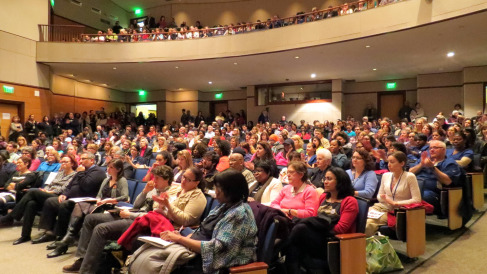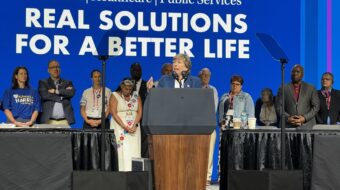
NEW HAVEN Conn. – Affordable, quality health care and secure, union jobs are both threatened by the growing consolidation and monopolization of the medical industry. That was one message from a panel sponsored by Locals 34 and 35 of Unite Here, the union representing clerical, technical, service, and maintenance workers at Yale University.
The other message, brought from a successful struggle at another hospital, and from militant audience members, is that organizing, unity and solidarity is a winning strategy. To set the stage, several experts were asked to discuss trends in hospital consolidation.
Ben Barnes, Secretary of Connecticut’s Office of Policy and Management, explained that health care providers are reorganizing to maximize revenue and cut costs. His office is concerned that health care not be undermined in the pursuit of profit, including through hospital acquisition of specialist practices.
Joseph Neff, investigative reporter for the Raleigh News & Observer, gave examples from his state. Ninety percent of specialists are employed by two hospital systems. Neff noted that 25 hospital executives in North Carolina make more than $1 million per year, and none is a practicing physician. Saying, “Bigger is not cheaper, it is more expensive,” Neff gave examples of huge increases in fees and drug charges when specialist practices and clinics are taken over by big hospitals.
Dr. Paul Taheri, CEO of Yale Medical Group, provided a different perspective. Massive consolidation is a national phenomenon, he said, and it’s not easy on physicians either. Citing a variety of costs Yale New Haven Hospital (YNHH) bears, he said they have to expand profit centers because they have so many loss centers. “I can’t imagine how confusing it must be for patients,” he said, warning that more change is coming and “I don’t know what will be coming next.”
George Jepsen, Attorney General for the state of Connecticut, discussed factors driving the price increases, and described legislation he has introduced requiring hospitals disclose their fees and acquisitions.
What made the evening different were the audience, and the fifth panelist.
Most of the audience were members of Locals 34 and 35, along with concerned community activists. One of the union members worked at the Yale Sleep Lab for 16 years. The sleep lab, employing Local 34 members, closed because, according to Taheri, it ran out of funds. At the same time – by coincidence, Taheri said – the hospital purchased an off-site sleep center, which will not be covered by the University’s union contract. To continue with the work she loves, caring for patients who depend on her, this worker will be forced to accept a $6 hourly pay cut and lose union benefits.
Other workers expressed similar concerns. Yale unions have been battling subcontracting for years. There have been real gains, including a no-layoff clause for Local 35, and strong internal hiring preference for Local 34 with up to 18 months salary continuation for any worker who is laid off. But the gains are always threatened – contracting out food service and janitorial work in new buildings, closing or cutting academic departments and transferring work to the non-union hospital.
The audience really came to life when panelist Lisa D’Abrosca took the microphone. D’Abrosca, a RN, is president of AFT Local 5049, one of two locals representing workers at L&M Hospital in New London, Conn. Coming off of hard-fought strike and lockout in bitter winter weather, she had a different perspective from other speakers, she said, speaking from the workers’ and patients’ standpoint. She illustrated clearly how patients, as well as workers, can benefit from a union that has strong community support.
According to D’Abrosca, L&M took advantages of changes in the healthcare system affecting two services. One was the OB/GYN clinic. The clinic didn’t make money because poor people used it. L&M dropped the clinic, laid off several union workers, and replaced them with one non-union worker.
They did the same with outpatient psych services. It was located downtown, with easy access by public transport. L&M bought up doctors’ practices scattered around the surrounding area, replacing the downtown location. The scattered offices are not on bus lines. Union workers were laid off.
The challenges faced by workers at L&M Hospital and by workers at Yale University are faced by millions of American workers as corporate profits soar. As Harold Meyerson reports in American Prospect, “In recent decades, companies have routinely shifted the production and delivery of their goods and services and other tasks needed to run their businesses from their own employees to workers employed by contractors, subcontractors, franchisees, or temporary job agencies or to workers who are labeled independent contractors. In many cases, these workers are the same workers the parent company once employed. In most cases, they could be employed directly by the parent company, but they’re not, chiefly because having the labor done by nonemployees saves the parent company money.”
At L&M Hospital, because the workers have a union with strong support from the labor movement and the community, the employer offensive was blunted. D’Abrosca reported that the union achieved its main goal: a guarantee that the union workers would follow the work. “If tables and chairs and patients were moved, that we would follow.”
Her take home message, “If we didn’t stand up for ourselves we would get steamrollered,” was greeted with loud applause. “A job here and a job there a before you know it there would be a shell of a hospital.” More applause. “We did what we had to to protect ourselves and our patients.” The whole audience rose and cheered.
This strong message from a sister union resonates with Yale workers. Whether at the Medical School or in other departments, workers report budget cuts and reorganization, threatening workers’ jobs and the services they provide. Locals 34 and 35 have been holding meetings and circulating petitions in the departments. While the unions have had relatively good relations with the Yale administration in recent years, in the past the University experienced 30 years of stormy labor relations, including multiple long and bitter strikes. The workers do not seek confrontation, but they are determined to protect the gains and security they have won.
On the surface, it would seem that university workers, hospital workers, fast food and retail workers, postal workers, and home childcare and health providers have little in common. But all are experiencing or are threatened by the trends mentioned by Meyerson, toward a “new normal” of low-wage, low-benefit, precarious employment, turning the working class into what has been called the “precariat”.
Recognizing the common threat can help promote the political and organizational unity necessary to make every job a secure, living-wage, union job.
Photo: Unite Here Local 34












Comments